Ecola State Park
- January 30, 2024
- 0 comment
Discover Ecola State Park’s breathtaking coastal views, lush rainforest trails, and iconic Cannon Beach vistas in Oregon’s natural splendor. Located along the scenic Oregon coast, Ecola State Park offers a mesmerizing blend of natural beauty and adventure. With its panoramic ocean views, this park is a haven for those seeking a tranquil retreat or an active day out in nature.
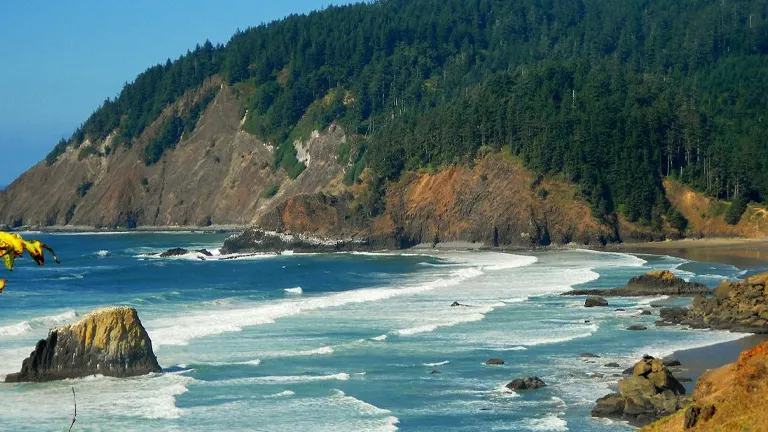
The lush rainforest trails invite visitors to wander through verdant landscapes, unveiling a variety of local flora and fauna. The park’s proximity to the iconic Cannon Beach adds to its allure, allowing visitors to experience the majestic sight of Haystack Rock rising from the ocean. Whether it’s hiking, picnicking, wildlife viewing, or simply soaking in the views, Ecola State Park is a destination that captivates and inspires.
Characterizing Features of Ecola State Park
- Breathtaking Coastal Views: Ecola State Park is renowned for its stunning views of the Pacific Ocean. Perched on the cliffs of the Oregon coast, visitors can gaze out at miles of pristine coastline, spotting landmarks like the Tillamook Rock Lighthouse in the distance. The viewpoints along the park offer an unparalleled opportunity to witness the power and beauty of the ocean, making it a favorite spot for photographers and nature lovers alike.
- Lush Rainforest Trails: The park is crisscrossed with trails that wind through dense, verdant rainforests. These paths are enveloped by a canopy of towering trees, including Sitka spruces and western hemlocks, creating a serene and mystical atmosphere. Hikers on these trails are treated to the sights and sounds of a thriving rainforest ecosystem, complete with fern-covered floors and the occasional stream cutting through the landscape.
- Proximity to Iconic Cannon Beach: Ecola State Park’s location near Cannon Beach adds to its allure. The park provides unique views of Cannon Beach’s most famous feature, Haystack Rock, a 235-foot sea stack that rises majestically from the ocean. This proximity allows visitors to easily combine a trip to the park with a visit to one of Oregon’s most beloved beaches, known for its fine sand, tide pools, and picturesque scenery.
- Rich Wildlife Habitat: The park serves as a crucial habitat for a variety of wildlife, especially bird species. It’s not uncommon to see bald eagles soaring above or hear the calls of seabirds. The dense forests and coastal cliffs provide ideal nesting and foraging grounds for these birds, making the park a prime location for birdwatching.
- Diverse Landscapes and Ecosystems: Ecola State Park is a showcase of diverse landscapes, from rugged coastline and sandy beaches to dense forest and open meadows. This variety creates a range of ecosystems within the park, each supporting different types of flora and fauna. The interplay of these environments makes Ecola State Park a microcosm of the Oregon coast’s natural diversity.
- Historical Significance: The park is steeped in history, with ties to the Lewis and Clark Expedition. It’s believed that members of the expedition traveled through the area in 1806. This historical connection adds a layer of depth to the park, combining natural beauty with a rich narrative that speaks to Oregon’s past.
- Recreational Opportunities: Beyond its natural and historical features, Ecola State Park is a hub for outdoor recreation. The park’s trails offer hiking opportunities for all skill levels, while the beaches are popular for surfing, tide pooling, and beachcombing. This blend of recreational activities ensures that the park appeals to a wide range of visitors, from adventure seekers to those looking for a peaceful retreat in nature.
History of Ecola State Park
Ecola State Park’s history is deeply intertwined with both natural evolution and human influence, tracing back thousands of years. Long before European settlers arrived, the area was inhabited by the Tillamook and Clatsop tribes, who utilized the land for fishing and hunting, making the most of its rich natural resources. The park’s name, “Ecola,” is derived from a Chinook word meaning “whale,” a testament to the area’s significance for the Native American tribes, particularly in whale hunting and trade. The park gained historical prominence in the early 19th century when it became a part of the route used by the Lewis and Clark Expedition. In January 1806, William Clark and members of the Corps of Discovery journeyed through the area in search of a beached whale near present-day Cannon Beach, marking a significant event in their expedition and the early history of the Pacific Northwest.
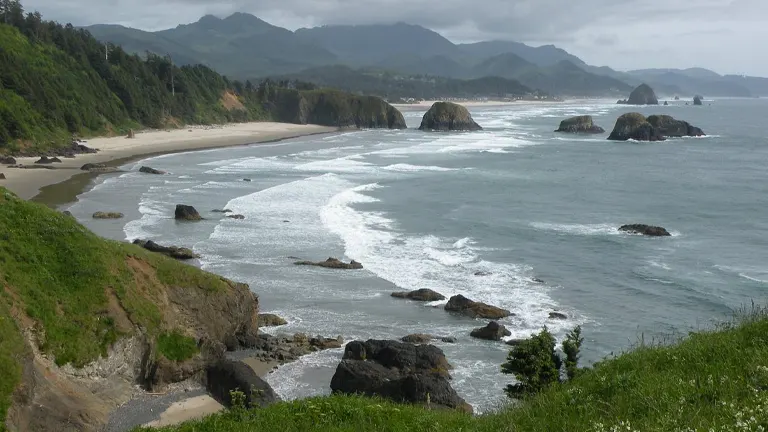
As the 19th century progressed, the area surrounding Ecola State Park saw increased settlement and development. However, it wasn’t until the 20th century that the land’s value as a public natural area was recognized. The push for preservation led to its designation as a state park in the 1930s, a move that protected its unique landscapes and ecosystems. Throughout the 20th century, the park underwent various developments to enhance its accessibility and visitor facilities while maintaining its natural beauty. Today, Ecola State Park stands not only as a spectacular natural area but also as a historical landmark, representing centuries of natural history and human exploration. Its well-preserved landscapes and rich cultural history continue to draw visitors from all over the world, making it an integral part of Oregon’s coastal heritage.
Unique Ecosystem of Ecola State Park
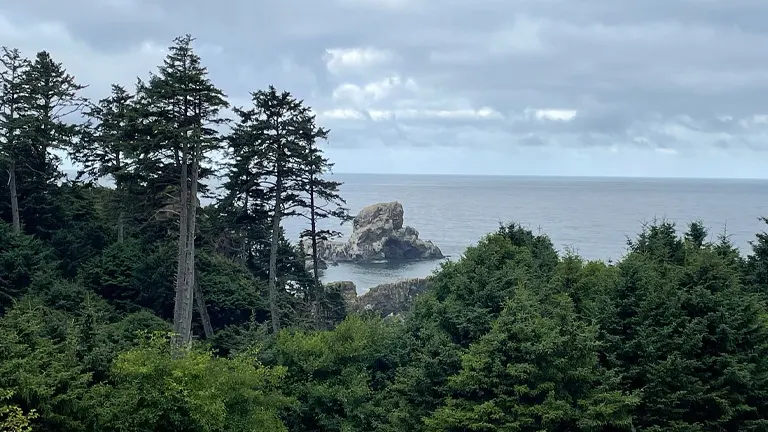
Ecola State Park boasts a unique and diverse ecosystem, a testament to the rich environmental tapestry of the Oregon coast. The park is a harmonious blend of maritime and terrestrial habitats, featuring rugged cliffs, dense coastal rainforests, and serene beaches. These varied landscapes create a mosaic of ecosystems that support an array of wildlife and plant species. In the lush, moisture-laden forests, towering Sitka spruces and western hemlocks dominate, providing habitat for a variety of bird species, including the majestic bald eagle and the elusive pileated woodpecker. Along the coastline, tide pools teem with marine life such as starfish, anemones, and crabs, while the offshore waters are frequented by migrating gray whales, seals, and sea lions. This ecological diversity is further enriched by the park’s understorey of ferns, mosses, and a rich array of understory plants, creating a vibrant and resilient ecosystem that is both a haven for wildlife and a natural laboratory for ecological study.
Location of Ecola State Park
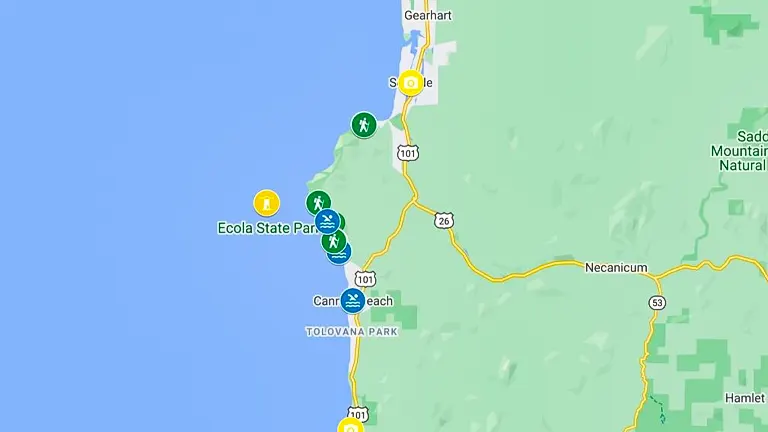
Ecola State Park is situated in the scenic region of the northern Oregon coast, nestled between the quaint town of Cannon Beach and the city of Seaside. Located approximately 80 miles northwest of Portland, the park is easily accessible via Highway 101, known for its picturesque coastal route. This prime location offers stunning views of the Pacific Ocean, framed by dramatic headlands and lush, forested hillsides. The park’s close proximity to Cannon Beach makes it a popular destination, allowing visitors to experience the charm of one of Oregon’s most beloved coastal towns, famous for its iconic Haystack Rock. The park’s strategic location also serves as a gateway to exploring the broader Oregon coastline, known for its rugged beauty and diverse landscapes, making it an ideal starting point for those seeking to immerse themselves in the Pacific Northwest’s coastal environment.
Here’s a guide on how to reach Ecola State Park with specific details:
1. From Portland, Oregon:
- Take US-26 W from Portland towards the Oregon Coast.
- Continue on US-26 W for about 70 miles.
- Near the town of Elsie, switch to Highway 53 S towards the coast for a more scenic route, or stay on US-26 W until it meets Highway 101.
- Once on Highway 101, head north towards Cannon Beach.
- Follow the signs to Ecola State Park, which is located just north of Cannon Beach.
2. From Seattle, Washington:
- Start on I-5 S towards Portland.
- Take exit 36 for WA-432 W towards Longview/Kelso.
- Merge onto WA-432 W, which becomes WA-433 S.
- Cross into Oregon over the Lewis and Clark Bridge and continue on US-30 W.
- Join Highway 101 S and follow it down the Oregon Coast.
- Ecola State Park is located just south of Seaside, before reaching Cannon Beach.
3. Using Public Transportation:
- While direct public transportation to Ecola State Park is limited, you can take a bus or train to nearby cities like Seaside or Cannon Beach.
- From there, taxi services or local shuttle services can be used to reach the park.
- Check local transit websites for the most current routes and schedules.
4. For International Visitors:
- Fly into Portland International Airport (PDX).
- Rent a car at the airport and follow the driving directions from Portland.
5. Accommodation Nearby:
- Consider staying in Cannon Beach or Seaside, as both offer a range of lodging options and are conveniently close to the park.
6. When Driving:
- Check road conditions and traffic updates, especially during peak tourist seasons and in winter.
- Oregon’s coastal weather can be unpredictable, so plan your driving accordingly.
7. Parking at the Park:
- Ecola State Park has limited parking spaces, especially during peak season. Arrive early to secure a spot.
- Pay attention to park signage for parking instructions and restrictions.
The Importance of Conservation and Recreation in Ecola State Park
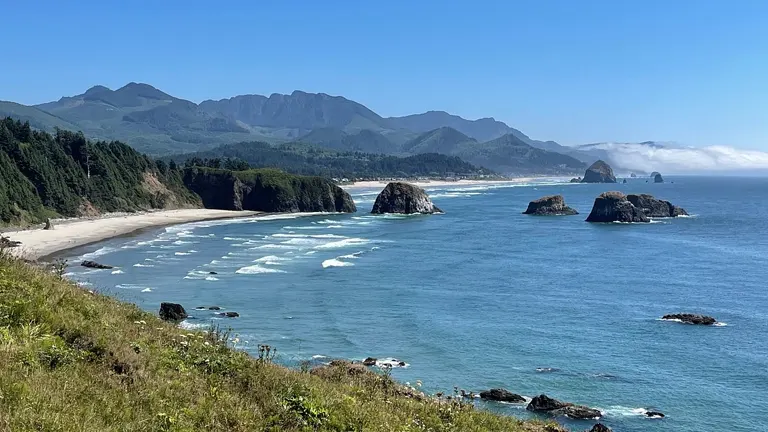
The importance of conservation and recreation in Ecola State Park is paramount, reflecting a delicate balance between preserving natural beauty and providing public enjoyment. As a protected area, the park plays a critical role in conserving diverse habitats, from its coastal cliffs and rainforests to the marine environments. These efforts safeguard the home of numerous species, ensuring ecological stability and biodiversity. Simultaneously, the park serves as a recreational haven, offering hiking, wildlife viewing, and beach activities that foster a deep appreciation for nature among visitors. This dual focus not only enhances the visitor experience but also promotes environmental stewardship. By maintaining this balance, Ecola State Park ensures that its unique landscapes and ecosystems continue to thrive, providing a sustainable and enriching experience for future generations while serving as a model for conservation and responsible recreation in natural settings.
Diverse Vegetation and Plant Species in Ecola State Park
- Sitka Spruce (Picea sitchensis): Dominating the park’s landscape, the Sitka Spruce is a towering conifer that thrives in the moist coastal environment. Its presence is a hallmark of the Pacific Northwest, and these trees can live for hundreds of years, providing essential habitat for various wildlife species.
- Western Hemlock (Tsuga heterophylla): Often found alongside the Sitka Spruce, the Western Hemlock is another significant conifer in the park. This tree is known for its feathery foliage and drooping top, contributing to the dense, green canopy that characterizes the park’s forests.
- Sword Fern (Polystichum munitum): This robust fern is ubiquitous on the forest floor, contributing to the lush undergrowth of the park. Its long, sword-like fronds are a common sight along the park’s trails, adding to the dense, green landscape.
- Salal (Gaultheria shallon): A versatile evergreen shrub, Salal is prevalent in the park’s understory. It produces dark berries and leathery leaves, playing a crucial role in the forest ecosystem as both a food source for wildlife and a ground cover that helps prevent erosion.
- Oregon Grape (Mahonia aquifolium): Known for its holly-like leaves and yellow flowers, Oregon Grape is a native shrub that adds color to the park’s landscape. Its blue-black berries are a food source for birds and small mammals.
- Red Alder (Alnus rubra): Typically found in wetter areas of the park, the Red Alder is a deciduous tree that helps enrich the soil through nitrogen fixation. Its presence is vital for forest regeneration and ecosystem health.
- Coastal Strawberry (Fragaria chiloensis): Common along the coastal areas of the park, this groundcover plant produces small, edible strawberries. Its presence contributes to the park’s biodiversity and offers a delicate beauty to the landscape.
- Skunk Cabbage (Lysichiton americanus): Found in marshy, wet areas, Skunk Cabbage is notable for its large yellow spathe and distinct odor. This plant is crucial for wetland ecosystems, providing early spring nectar for insects.
- Beachgrass (Ammophila): Vital for dune stabilization, Beachgrass is often seen in the sandy areas near the beach. Its long roots help hold the sand in place, protecting the coastline from erosion.
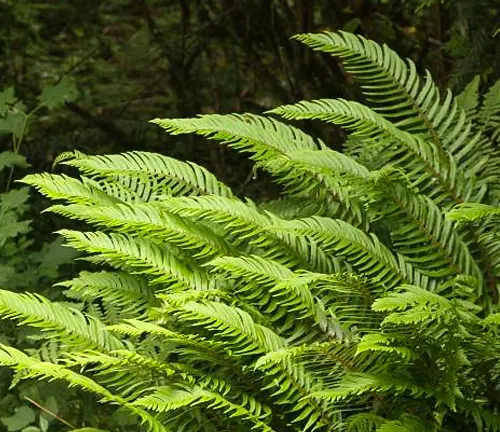
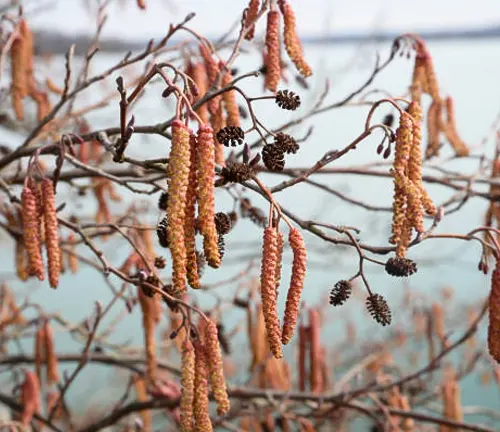
Fauna in Ecola State Park
- Roosevelt Elk (Cervus canadensis roosevelti): The majestic Roosevelt Elk is a common sight in the park’s meadows and forests. These large mammals are a subspecies of elk found in the Pacific Northwest and are named after President Theodore Roosevelt. They play a crucial role in the ecosystem as grazers, helping to maintain open landscapes within the forest.
- Bald Eagle (Haliaeetus leucocephalus): A symbol of American wildlife, the Bald Eagle is often seen soaring high above the park. These powerful birds of prey nest in the tall trees of Ecola State Park and are a spectacular sight for visitors, especially during their nesting and breeding season.
- Black-Tailed Deer (Odocoileus hemionus columbianus): These graceful creatures are a common sight, especially at dawn and dusk. The black-tailed deer is a subspecies of mule deer, and they play a significant role in the park’s ecosystem as browsers, feeding on a variety of plants.
- Banana Slug (Ariolimax columbianus): This large, yellow slug is a unique and fascinating resident of the park’s rainforest. Banana slugs are crucial decomposers, breaking down dead organic material and recycling nutrients back into the soil.
- Pileated Woodpecker (Dryocopus pileatus): Known for their distinctive red crest and loud calls, these woodpeckers are an essential part of the park’s forest ecosystem. They create large holes in trees while searching for insects, which later become nesting sites for other bird species.
- Western Gray Squirrel (Sciurus griseus): These agile squirrels are commonly found in the park’s forests. They play a vital role in seed dispersal, aiding in the growth of new plants and trees throughout the park.
- Steller’s Jay (Cyanocitta stelleri): Recognizable by its striking blue feathers and loud calls, the Steller’s Jay is a common bird in the park. These birds are known for their intelligence and play an important role in the dispersal of seeds and nuts.
- Harbor Seal (Phoca vitulina): Frequently spotted along the park’s coastline and rocky outcrops, harbor seals are a vital part of the marine ecosystem. These seals can often be seen basking on rocks or swimming in the nearby waters.
- Sea Stars and Anemones (Various species): In the park’s tide pools, a colorful array of sea stars and anemones can be found. These marine creatures are a vital part of the intertidal ecosystem, contributing to the biodiversity of the region.
- Peregrine Falcon (Falco peregrinus): Known as one of the fastest birds in the world, the Peregrine Falcon is sometimes spotted in the park. These raptors play a crucial role as predators in the ecosystem, helping to maintain a balance in the bird populations.
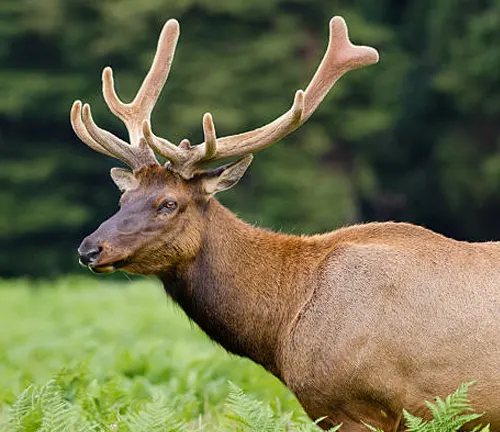

Attractions in Ecola State Park
Indian Beach: A secluded and picturesque beach, Indian Beach is a favored spot for both locals and visitors. Surrounded by towering cliffs and lush forestry, it offers a more tranquil alternative to the often-busier Cannon Beach. Ideal for surfing, tide pooling, and wildlife viewing, this beach is also a popular location for photographers, thanks to its stunning coastal scenery and the dramatic backdrop of sea stacks.
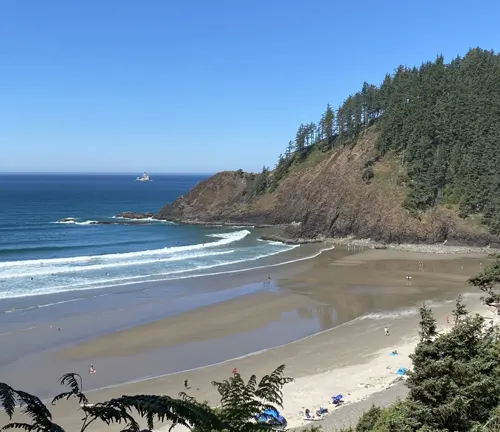

Tillamook Rock Lighthouse Viewpoint: Known as “Terrible Tilly,” this offshore lighthouse can be viewed from a designated viewpoint in the park. Perched on a rocky islet, the lighthouse has a rich history and adds a sense of mystery to the seascape. The viewpoint not only offers a clear view of this historic structure but also provides sweeping vistas of the Pacific Ocean, making it a perfect spot for sightseeing and photography.
Clatsop Loop Trail: This trail is a highlight for hikers, offering a moderately challenging hike with rewarding views. The trail takes visitors through lush coastal forest, opening up to spectacular ocean views. It’s steeped in history too, as it partially follows the route taken by Captain William Clark and members of the Corps of Discovery in 1806.
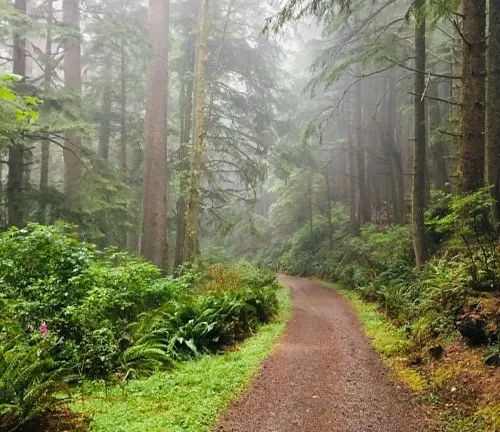
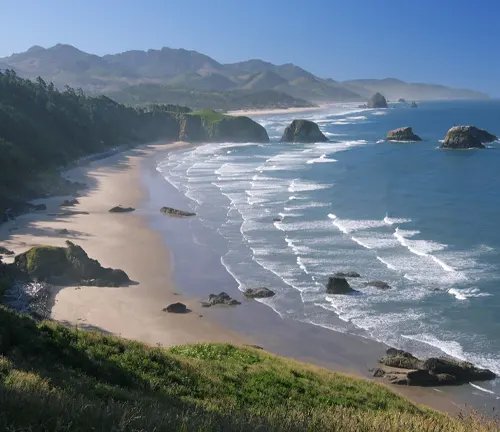
Crescent Beach: Accessible via a hike from Ecola Point, Crescent Beach is a hidden gem within the park. This secluded beach is encircled by cliffs and forest, creating a serene and private atmosphere. It’s an ideal spot for those looking to escape the crowds and enjoy a peaceful beach experience.
Picnic Areas: Scattered throughout the park are several picnic areas, where visitors can relax and enjoy a meal amidst the natural beauty. These areas are equipped with tables and situated in scenic locations, making them perfect for family outings or a peaceful break during exploration.
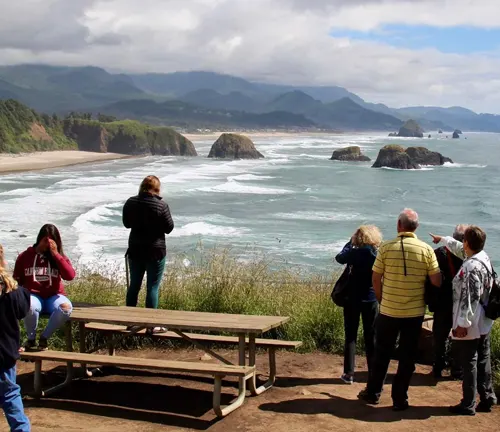
Recreational Activities in Ecola State Park
- Hiking: Ecola State Park is a hiker’s paradise, offering a variety of trails that cater to different skill levels. From the easy, scenic strolls along the coastline to more challenging hikes through the dense rainforest, each trail provides a unique experience. The Clatsop Loop Trail, for example, offers historical significance and stunning ocean views, while the hike to Crescent Beach challenges adventurers with a more secluded and rugged path.
- Surfing at Indian Beach: Indian Beach is a well-known spot in the park for surfing enthusiasts. Its relatively secluded location and consistent wave conditions make it an ideal spot for both beginners and experienced surfers. The picturesque setting, surrounded by cliffs and forests, adds to the unique surfing experience.
- Wildlife Viewing: The park’s diverse ecosystems make it an excellent place for wildlife viewing. Visitors can spot Roosevelt elk in the meadows, observe a variety of bird species including bald eagles and Peregrine falcons, or catch a glimpse of marine life such as seals and sea stars, especially around the tide pools.
- Photography: With its stunning landscapes, ranging from vast ocean views to dense forests, Ecola State Park is a haven for photographers. Whether capturing the dramatic sunset over the Pacific, the historic Tillamook Rock Lighthouse, or the diverse flora and fauna, the park offers endless subjects for both amateur and professional photographers.
- Picnicking: The park provides numerous picnic areas, perfectly situated for visitors to enjoy a meal with a view. These areas offer a mix of sun and shade, with breathtaking views of the ocean or the tranquility of the forest, making for an ideal family outing or a romantic lunch spot.
- Beachcombing and Tide Pooling: The beaches within Ecola State Park, especially Indian Beach, are perfect for beachcombing and exploring tide pools. Visitors can discover a variety of marine life in the tide pools, while beachcombing can yield interesting finds like driftwood, shells, and occasionally, agates.
- Bird Watching: Bird enthusiasts will find the park a rewarding location for bird watching. The diverse habitats support a range of bird species, from seabirds along the coast to forest dwellers. The park’s quiet and natural setting provides an ideal environment for observing these birds in their natural habitat.
- Whale Watching: During migration seasons, Ecola State Park becomes a prime spot for whale watching. Visitors can look out for gray whales migrating along the coast, an awe-inspiring sight that attracts nature lovers from all over.


Different Facilities and Amenities in Ecola State Park
- Parking Areas: Ecola State Park provides several parking areas for visitors. The main parking area near Ecola Point offers easy access to the park’s central features and trails. Additional parking is available at Indian Beach, catering to beachgoers and surfers. These well-maintained parking facilities are strategically located for convenient access to various parts of the park.
- Restrooms: The park is equipped with restroom facilities at key locations, including near the main entrance, at Ecola Point, and at Indian Beach. These facilities are essential for visitor comfort, especially for those spending a full day exploring the park.
- Picnic Areas: Scattered throughout Ecola State Park are several picnic areas, complete with tables and sometimes grills. These areas provide a perfect setting for families and groups to enjoy a meal surrounded by natural beauty. Some picnic spots offer spectacular views of the ocean or are nestled in quieter, forested areas.
- Viewpoints and Lookouts: One of the park’s highlights is its numerous viewpoints and lookouts, offering panoramic views of the Pacific Ocean, coastline, and landmarks like Haystack Rock and Tillamook Rock Lighthouse. These viewpoints are accessible via short walks from the parking areas and are equipped with safety railings and interpretive signage.
- Trail Markers and Information Boards: Throughout Ecola State Park, well-placed trail markers and information boards guide visitors. These markers provide directions, distances, and difficulty ratings for trails, while information boards offer insights into the park’s history, wildlife, and vegetation.
- Trash and Recycling Bins: To maintain the park’s cleanliness and environmental health, trash and recycling bins are provided at various locations. Visitors are encouraged to use these facilities to help keep the park pristine and protect its natural habitats.
- Benches and Seating Areas: Along the trails and at viewpoints, benches and seating areas are available for visitors to rest and take in the surroundings. These spots are ideal for relaxing, wildlife viewing, or simply enjoying a moment of tranquility in nature.
- Emergency Services: While the park is a natural area, it is equipped with emergency services, including park rangers who patrol the area. These services ensure the safety and well-being of visitors during their time in the park.
Tips and Advice for Visiting Ecola State Park
- Check Weather Conditions: Before heading to Ecola State Park, it’s crucial to check the local weather forecast. The coastal climate can be unpredictable, with rapid changes in weather conditions. Preparing for rain, wind, or fog, especially outside of summer months, can greatly enhance your experience.
- Wear Appropriate Footwear: Given the park’s diverse terrain, from sandy beaches to forest trails, wearing sturdy, comfortable footwear is advisable. Hiking boots are recommended for trails, which can be muddy or slippery, especially after rain.
- Respect Wildlife: The park is home to a variety of wildlife, and it’s important to observe them from a distance without disturbing their natural behaviors. Feeding wildlife is discouraged as it can harm their health and alter natural behaviors.
- Stay on Designated Trails: For your safety and to preserve the park’s delicate ecosystems, always stay on marked trails. Venturing off trails can lead to erosion and damage to vegetation, as well as pose personal safety risks.
- Pack Out What You Pack In: To help maintain the park’s natural beauty, carry out all your trash and belongings. Littering not only spoils the scenery but can also be harmful to wildlife. Utilize the provided trash and recycling bins.
- Plan Your Visit During Off-Peak Hours: Ecola State Park can get crowded, especially during summer and on weekends. Visiting during off-peak hours, such as early morning or weekdays, can offer a more peaceful experience.
- Be Prepared for Limited Cell Service: In some areas of the park, cell phone service can be spotty or nonexistent. Plan accordingly by informing others of your itinerary and considering carrying a map or a GPS device for navigation.
- Parking Considerations: The park’s parking areas can fill up quickly, especially on weekends and holidays. Arriving early in the day can help ensure you find a parking spot. Also, remember to pay the parking fee, which helps with the maintenance of the park.
- Be Cautious Near Cliffs and the Ocean: The park’s cliffs are beautiful but can be dangerous. Keep a safe distance from cliff edges, as they can be unstable. When exploring beaches, be aware of tides to avoid getting cut off by rising water.
- Check for Park Alerts or Closures: Before your visit, check any park alerts or closures. Sometimes trails or areas of the park may be closed for maintenance, wildlife protection, or due to weather conditions.
Recommendation
Ecola State Park is a must-visit gem on the Oregon Coast, offering stunning ocean views, rich wildlife, and picturesque trails. Perfect for nature lovers and adventure seekers alike, it’s an ideal spot for a memorable day of exploration and scenic beauty. Don’t miss this captivating coastal escape!
Conclusion
In summary, Ecola State Park is a captivating showcase of the Oregon Coast’s natural splendor. With its stunning vistas, diverse wildlife, and rich array of activities, it offers an unforgettable experience for all who visit. This park is truly a jewel in Oregon’s crown, a must-see for nature enthusiasts and outdoor adventurers alike.
FAQs
- Is there an entrance fee for Ecola State Park?
Yes, there’s a small day-use fee for entering the park, which contributes to its maintenance and conservation. - Can I bring my dog to Ecola State Park?
Yes, dogs are allowed but must be kept on a leash at all times to protect wildlife and ensure the safety of all park visitors. - Are there camping facilities within Ecola State Park?
No, overnight camping is not allowed in Ecola State Park, but there are several campgrounds nearby. - What type of wildlife might I see in the park?
Visitors can see a variety of wildlife, including Roosevelt elk, black-tailed deer, numerous bird species like bald eagles and woodpeckers, and marine animals such as seals and sea stars. - Are there guided tours available in Ecola State Park?
The park does not regularly offer guided tours, but visitors can explore the park through self-guided trails and viewpoints with interpretive signage. - What should I wear when visiting the park?
It’s best to wear layers, as the weather can change rapidly. Sturdy footwear is recommended for hiking on the trails. - Is Ecola State Park accessible year-round?
Yes, the park is open year-round, but certain trails or areas may be closed due to weather conditions, especially in the winter. - Are there any restrictions on activities in the park?
To protect the park’s natural environment, activities like drone flying, off-trail hiking, and wildlife feeding are restricted or prohibited. Always check current park rules before your visit.
Ecola State Park is a true treasure of the Oregon Coast, offering unforgettable scenic beauty and outdoor adventures. A visit here is a lasting memory, inviting you back to its natural splendor time and again.



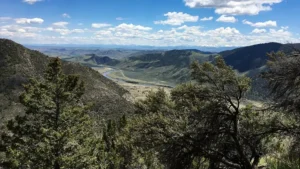
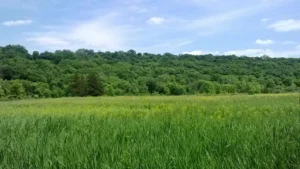

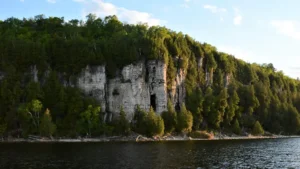


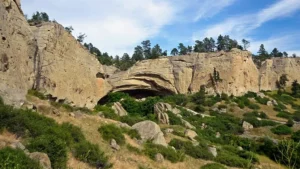
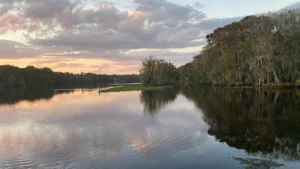
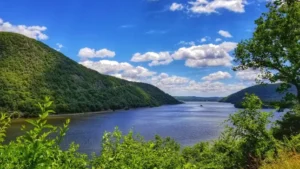
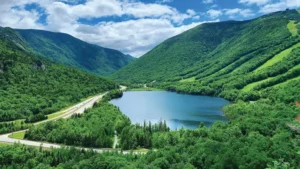
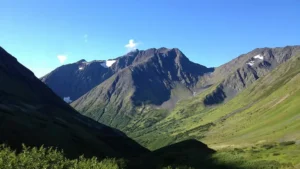
Leave your comment